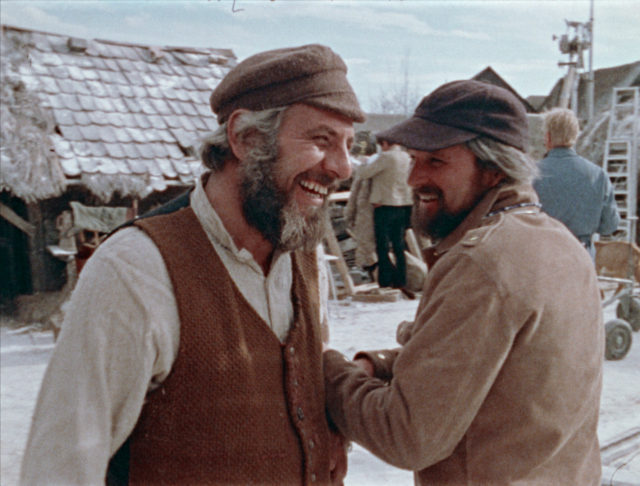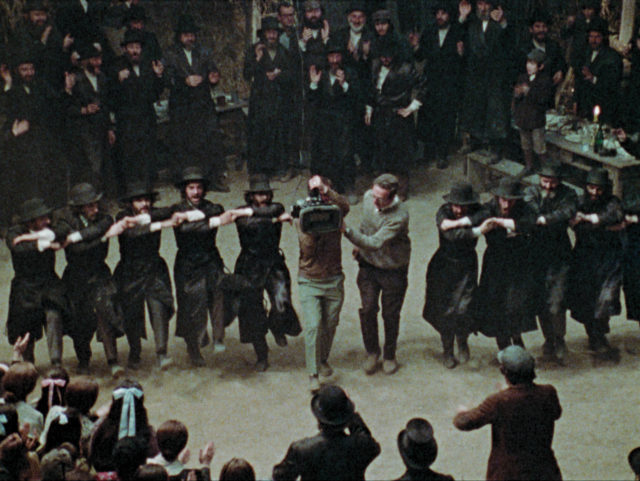
Star Chaim Topol and director-producer Norman Jewison kid around on the set of Fiddler on the Roof
FIDDLER’S JOURNEY TO THE BIG SCREEN (Daniel Raim, 2022)
Angelika Film Center
18 West Houston St.
Opens Friday, April 29
www.angelikafilmcenter.com
zeitgeistfilms.com
Daniel Raim takes viewers behind the scenes of the making of one of the most beloved musicals of all time in Fiddler’s Journey to the Big Screen, opening April 29 at the Angelika. Raim follows the development of the 1964 Broadway smash Fiddler on the Roof, which ran for 3,242 performances and won nine of the ten Tonys it was nominated for, into the classic 1971 film that was up for eight Oscars and won three.
The documentary is anchored by a series of talks with Fiddler’s director and producer, Canadian filmmaker Norman Jewison, who had previously made The Cincinnati Kid, In the Heat of the Night, and The Russians Are Coming, the Russians Are Coming and would go on to direct and produce Jesus Christ Superstar, A Soldier’s Story, and Mooonstruck. One of the first things we learn about Jewison is that he isn’t Jewish.
Recalling the initial meeting he had with United Artists executives, Jewison recalls, “[Studio head] Arthur Krim looked at me and he says, ‘What would you say if we were to say we want you to produce and direct Fiddler on the Roof?’ And my heart came up into my mouth and I thought, Oh my G-d. And I looked over, waited, and they waited, and they all kind of leaned forward. They thought, What is he waiting for? And then I said, ‘What would you say if I told you I’m a goy?’” He got the job because, as Krim explained, “We want a film for everybody.”

Documentary goes behind the scenes of the making of Fiddler on the Roof
Raim incorporates old and/or new interviews with vibrant lyricist Sheldon Harnick, who turns ninety-eight on April 30 (the score was composed by Jerry Bock, who passed away in 2010); musical director and conductor John Williams, who is featured extensively; production designer Robert F. Boyle, who was Raim’s professor at AFI; cinematographer Oswald Morris; American film critic Kenneth Turan; and Israeli star Chaim Topol, who nabbed the role of Tevye from Zero Mostel, who played the anguished, deeply religious father on Broadway. The film is worth seeing just for the lovely interviews with the three actresses who portrayed the three oldest daughters, none of whom marry the men their parents prefer: Rosalind Harris (Tzeitel), Michele Marsh (Hodel), and Neva Small (Chava). “What a gift I was given,” Marsh, nearly in tears, remembers.
Discussing his approach to the cross-cultural nature of the story, which was based on the 1894 Yiddish tales of Tevye the dairyman by Sholem Aleichem, Jewison points out, “Themes of family is universal; everybody has a family — good or bad, right or wrong, we all have a family, and we all have our little problems. But we all end up sitting around the table. And I thought, this is so common, this is something people can understand. They can understand a family. They can understand Golde. They can understand Tevye; they can understand his problems with life and his relationship to G-d. I think all of these things, all put together, make the story of Fiddler on the Roof so compelling.”
More than a dozen years in the making, Fiddler’s Journey can be a bit scattershot and is supplemented with occasional narration by Jeff Goldblum that feels like filler, consisting primarily of excerpts from Jewison’s This Terrible Business Has Been Good to Me, Alisa Solomon’s Wonder of Wonders: A Cultural History of Fiddler on the Roof, and Morris’s Huston, We Have a Problem: A Kaleidoscope of Filmmaking Memories. Unfortuntely, these distract from the main narrative, which is packed with fabulous details about everything from the construction of the synagogue, Frank Sinatra’s desire to play Tevye, and the stocking Boyle placed over the lens of the camera to the influence of Marc Chagall’s paintings, Harris understudying Bette Midler onstage, and the involvement of Isaac Stern.
The wealth of material includes archival stills and film footage, Mentor Huebner’s storyboards, and photos by Roman Vishniac that inspired the look of the movie, which was shot in Lekenik in what was then Yugoslavia. There are also in-depth looks at such treasured songs as “Matchmaker, Matchmaker,” “If I Were a Rich Man,” “Sunrise, Sunset,” and “Do You Love Me?”
The Fiddler on the Roof movie might be fifty years old now, but its impact is as powerful and, sadly, as relevant as ever. “One of the things that Fiddler is about: Nothing is permanent,” Turan says. Long before the Russian invasion of Ukraine — Aleichem was born and raised in Kyiv — the show (most recently revived in Yiddish by the National Yiddish Theatre Folksbiene at the Museum of Jewish Heritage) and the film captured the pain of refugees forced to leave their home. Raim’s (Harold and Lillian: A Hollywood Love Story, The Man on Lincoln’s Nose about Boyle) documentary was completed prior to the invasion, but it’s impossible to watch it without thinking about all the Anatevkas we see on the news every day, in Ukraine and around the world.
(Raim will be at the Angelika on April 29 and 30 for Q&As following the 7:25 screenings, joined by Small and Harris.)